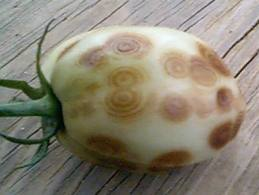The spotted wilt virus has a wide host range and can affect tomatoes, peppers, plus many other vegetables and ornamental plants. Early symptoms of spotted wilt on tomato are difficult to diagnose. Young, infected plants may show an inward cupping of leaves, and the foliage may appear light color or have a slight bronze cast. As the disease progresses, plants may develop dark brown to black streaks on the main stem. Occasionally the top portion of the plant appears yellow or wilts.
The most characteristic symptom of spotted wilt appears on the fruit. On young fruit white to yellow concentric rings will develop on the fruit skin. The area within the ring typically is raised, which gives the fruit a bumpy appearance. The bright yellow rings on mature red fruit are easily diagnosed as spotted wilt.
The spotted wilt virus is transmitted from plant to plant by several species of a small insect called a thrips. Thrips are less than ¼ inch in length, light green to brown in color and are extremely difficult to find on the plants. It is very important to keep the weeds around the garden controlled because many weedy plants serve as alternate hosts for the virus vectors.
Virus diseases cannot be controlled once the plant is infected. So plant resistant varieties*! Sanitation will help with controlling virus diseases. Infected plants should be removed immediately to prevent spread of the pathogens. Perennial weeds, which may serve as alternate hosts, should be controlled in and adjacent to the garden. Avoid planting tomatoes next to peppers, or other vegetables and flowers susceptible to these diseases. Preventative control of insects, especially thrips, will help reduce the likelihood of spotted wilt.
*BHN 602, Amelia, Crista, Quincy, Bella Rosa, Top Gun, Fletcher, Mountain
- Vegetable Garden Insect and Disease Management - June 10, 2015
- Insect Problems in the Heat of Summer - May 8, 2015
- Gardening in a Bucket - April 14, 2015


